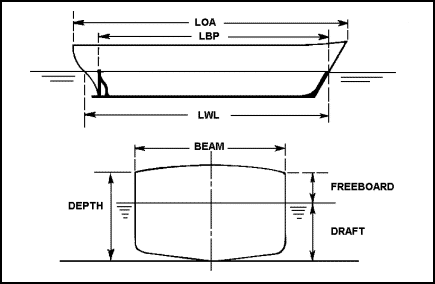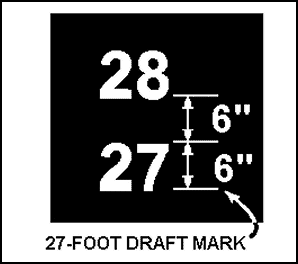Shipboard Measurements
A ship’s size and capacity can be described in two ways--linear dimensions or tonnages. Each is completely different yet interrelated.
A ship’s measurement is expressed in feet and inches--linear dimensions. A ship is a three dimensional structure having length, width, and depth.

A Ship’s Dimensions
LENGTH
A ship’s length is measured in different ways for ship’s officers, for architects and designers, and for registry. Terms used for technical or registry purposes include registered length, tonnage length, floodable length, and length by ABS rules. We mention these terms for familiarization only. The more commonly used length measurements -- length overall, length between perpendiculars, and length on load waterline are discussed as follows.
A ship’s Length Overall [LOA] is measured in feet and inches from the extreme forward end of the bow to the extreme aft end of the stern. Watercraft operators must be familiar with this and similar dimensions to safely maneuver the ship. The dimension is commonly found in lists of ship’s data for each vessel.
A ship’s length is sometimes given as Length Between Perpendiculars [LBP]. It is measured in feet and inches from the forward surface of the stem, or main bow perpendicular member, to the after surface of the sternpost, or main stern perpendicular member. This was believed to give a reasonable idea of the ship's carrying capacity, as it excluded the small, often unusable volume contained in her overhanging ends. On some types of vessels this is, for all practical purposes, a waterline measurement.
A ship’s Length on Load Waterline [LWL] is an important dimension because length at the waterline is a key factor in the complex problem of speed, resistance, and friction. On vessels with a counter stern, the LWL and LBP can be the same or about the same. On a ship with a cruiser stern, the LWL is greater than the LBP, as shown in the top portion of Figure 3-6.
WIDTH
A ship’s width or, more properly, a ship’s breadth is expressed in a number of ways and, like length, for a number of reasons.
A ship’s extreme breadth, commonly called beam, is measured in feet and inches from the most outboard point on one side to the most outboard point on the other at the widest point on the ship. This dimension must include any projections on either side of the vessel. Like length overall, this measurement is important to a ship’s officer in handling the vessel.
DEPTH
The depth of a vessel involves several very important vertical dimensions. They involve terms like freeboard, draft, draft marks, and load lines. The vessel’s depth is measured vertically from the lowest point of the hull, ordinarily from the bottom of the keel, to the side of any deck that you may choose as a reference point. Therefore, it has to be stated in specific terms such as depth to upper deck amidships. It is impractical to measure depth in any other way, since it varies considerably from one point to another on many ships. For example, the depth is greater at the stern than amidships.
The term "depth" is where the measurement is taken from the bottom--from the keel upward. Ordinarily, if such a measurement were being made in a room of a building, taken from the floor to the ceiling, it would be called height.
PROCEDURE FOR READING DRAFT MARKS
Draft marks are numbers marked on each side of the bow and stern of the vessel. Draft marks show the distance from the bottom of the keel to the waterline.

Draft Marks on Bow and Stern of Vessel
The draft numbers shown in the figure are 6 inches high and 6 inches apart. The bottom of each number shows the foot draft mark.

Draft Numbers Showing Foot Draft Mark
The next figure shows four different draft readings.

Various Draft Readings
WEIGHT TONNAGE TERMS
The word "ton" comes from the English "tun" meaning cask or barrel. To the English, it meant a wine barrel with a capacity of about 252 gallons. When Parliament imposed duties on the wine entering England in these barrels, the duty imposed on each tun eventually led to the use of tunnage in describing a ship’s capacity to carry such barrels. The original use of tun meant a barrel of a particular size, the space that such a barrel would occupy, and a ship’s capacity to carry a given number of such barrels. Tun was originally a figure for space--not weight. By law, Parliament fixed the tun at 252 gallons. Since this fixed tun weighed an average of 2,240 pounds, it brought into existence the weight term "long ton."
A long ton is used throughout the shipping business. It is not to be confused with the familiar ton of 2,000 pounds, the short ton, used so widely in the US in relation to so many things other than ships and shipping. The metric ton is 1,000 kilograms, the equivalent of 2,204.6 pounds. Tonnages normally refer to the long ton of 2,240 pounds.
DISPLACEMENT, LIGHT - The weight of the ship excluding cargo, fuel, ballast, stores, passengers, crew, but with water in boilers to steaming level.
DISPLACEMENT, LOADED - The weight of the ship including cargo, passengers, fuel, water, stores, dunnage and such other items necessary for use on a voyage, which brings the ship down to her load draft.
DEADWEIGHT - The total lifting capacity of a ship expressed in tons of 2240 lbs. It is the difference between the displacement light and the displacement loaded.
GROSS TONNAGE - The entire internal cubic capacity of the ship expressed in tons of 100 cubic feet to the ton, except certain spaces which are exempted, such as: (1) peak and other tanks for water ballast; (2) spaces above the uppermost continuous deck, such as: open forecastle, bridge and poop, certain light and air spaces, domes of skylights, condenser, anchor gear, steering gear, wheel house, galley and cabins for passengers.
NET TONNAGE - The tonnage most frequently used for the calculation of tonnage taxes and the assessment of charges for wharfage and other port dues. Net tonnage is obtained by deducting from the gross tonnage, crew and navigating spaces and an allowance for the space occupied by the propelling machinery.
CARGO DEADWEIGHT - Capacity is determined by deducting from total deadweight the weight of fuel, water, stores, dunnage, crew passengers, and other items necessary for use on a voyage.
The tonnage of combat ships is expressed in terms of displacement. The tonnage of cargo ships is typically measured measured in terms of deadweight [the net cargo capacity].
Ref: gobalsecurity.org 2005